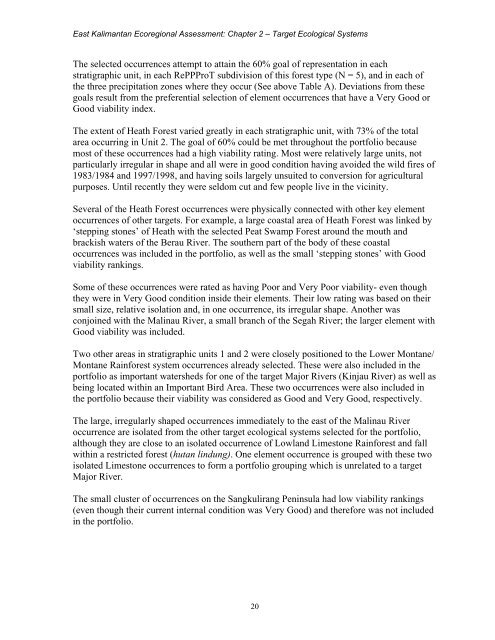Ecoregional Assessment of Biological Diversity in East Kalimantan
Ecoregional Assessment of Biological Diversity in East Kalimantan
Ecoregional Assessment of Biological Diversity in East Kalimantan
You also want an ePaper? Increase the reach of your titles
YUMPU automatically turns print PDFs into web optimized ePapers that Google loves.
<strong>East</strong> <strong>Kalimantan</strong> <strong>Ecoregional</strong> <strong>Assessment</strong>: Chapter 2 – Target Ecological Systems<br />
The selected occurrences attempt to atta<strong>in</strong> the 60% goal <strong>of</strong> representation <strong>in</strong> each<br />
stratigraphic unit, <strong>in</strong> each RePPProT subdivision <strong>of</strong> this forest type (N = 5), and <strong>in</strong> each <strong>of</strong><br />
the three precipitation zones where they occur (See above Table A). Deviations from these<br />
goals result from the preferential selection <strong>of</strong> element occurrences that have a Very Good or<br />
Good viability <strong>in</strong>dex.<br />
The extent <strong>of</strong> Heath Forest varied greatly <strong>in</strong> each stratigraphic unit, with 73% <strong>of</strong> the total<br />
area occurr<strong>in</strong>g <strong>in</strong> Unit 2. The goal <strong>of</strong> 60% could be met throughout the portfolio because<br />
most <strong>of</strong> these occurrences had a high viability rat<strong>in</strong>g. Most were relatively large units, not<br />
particularly irregular <strong>in</strong> shape and all were <strong>in</strong> good condition hav<strong>in</strong>g avoided the wild fires <strong>of</strong><br />
1983/1984 and 1997/1998, and hav<strong>in</strong>g soils largely unsuited to conversion for agricultural<br />
purposes. Until recently they were seldom cut and few people live <strong>in</strong> the vic<strong>in</strong>ity.<br />
Several <strong>of</strong> the Heath Forest occurrences were physically connected with other key element<br />
occurrences <strong>of</strong> other targets. For example, a large coastal area <strong>of</strong> Heath Forest was l<strong>in</strong>ked by<br />
‘stepp<strong>in</strong>g stones’ <strong>of</strong> Heath with the selected Peat Swamp Forest around the mouth and<br />
brackish waters <strong>of</strong> the Berau River. The southern part <strong>of</strong> the body <strong>of</strong> these coastal<br />
occurrences was <strong>in</strong>cluded <strong>in</strong> the portfolio, as well as the small ‘stepp<strong>in</strong>g stones’ with Good<br />
viability rank<strong>in</strong>gs.<br />
Some <strong>of</strong> these occurrences were rated as hav<strong>in</strong>g Poor and Very Poor viability- even though<br />
they were <strong>in</strong> Very Good condition <strong>in</strong>side their elements. Their low rat<strong>in</strong>g was based on their<br />
small size, relative isolation and, <strong>in</strong> one occurrence, its irregular shape. Another was<br />
conjo<strong>in</strong>ed with the Mal<strong>in</strong>au River, a small branch <strong>of</strong> the Segah River; the larger element with<br />
Good viability was <strong>in</strong>cluded.<br />
Two other areas <strong>in</strong> stratigraphic units 1 and 2 were closely positioned to the Lower Montane/<br />
Montane Ra<strong>in</strong>forest system occurrences already selected. These were also <strong>in</strong>cluded <strong>in</strong> the<br />
portfolio as important watersheds for one <strong>of</strong> the target Major Rivers (K<strong>in</strong>jau River) as well as<br />
be<strong>in</strong>g located with<strong>in</strong> an Important Bird Area. These two occurrences were also <strong>in</strong>cluded <strong>in</strong><br />
the portfolio because their viability was considered as Good and Very Good, respectively.<br />
The large, irregularly shaped occurrences immediately to the east <strong>of</strong> the Mal<strong>in</strong>au River<br />
occurrence are isolated from the other target ecological systems selected for the portfolio,<br />
although they are close to an isolated occurrence <strong>of</strong> Lowland Limestone Ra<strong>in</strong>forest and fall<br />
with<strong>in</strong> a restricted forest (hutan l<strong>in</strong>dung). One element occurrence is grouped with these two<br />
isolated Limestone occurrences to form a portfolio group<strong>in</strong>g which is unrelated to a target<br />
Major River.<br />
The small cluster <strong>of</strong> occurrences on the Sangkulirang Pen<strong>in</strong>sula had low viability rank<strong>in</strong>gs<br />
(even though their current <strong>in</strong>ternal condition was Very Good) and therefore was not <strong>in</strong>cluded<br />
<strong>in</strong> the portfolio.<br />
20

















